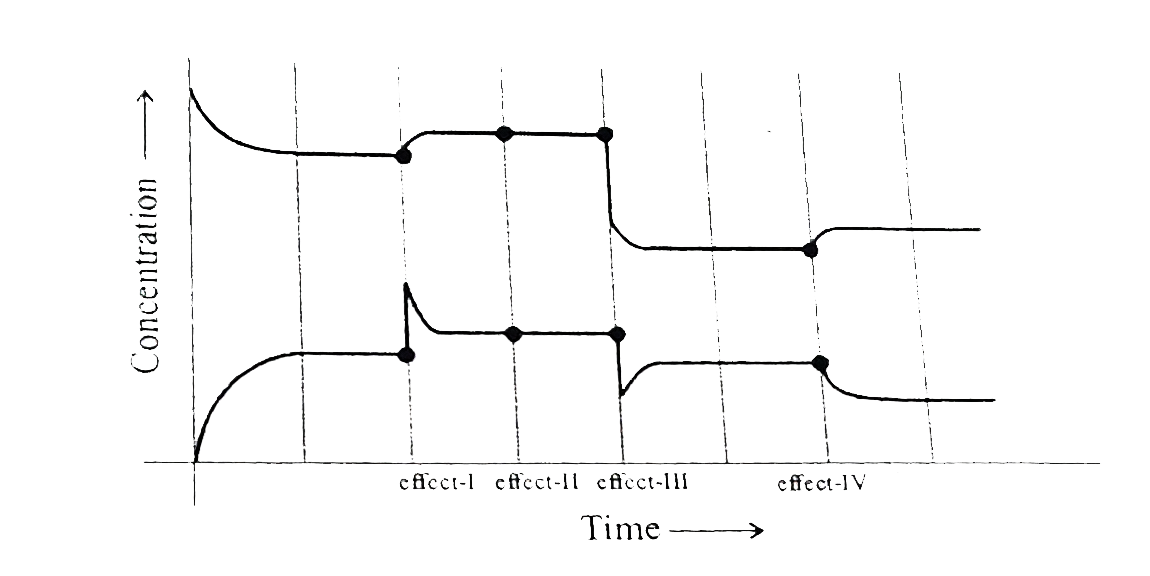For the given endothermic reaction
A(g)⇔2B(g)
The variation in concentration due to different changes is plotted. In column II various changes are given and you are supposed to match the entries in column-I with possible changes the system have undergone.
Neglect the slope of change in concentration when system approaches equilibrium. Assume that changes are carried out very fast.

The correct Answer is:(A)S (B)T ( C )P,Q (D) R
(A) According to praphic cone.of B is increased and equilibrium shift back ward & balance again to have how high equilibruim concentration of A&B.
There is no effect on conc. of A & B so it means inert gas is added at constant volume causing no. effect.
( C ) Concentration of A & B decreased. It means inert gas is added which decreases the pressure of A & B both and effect on eqution is such that equation shift forward.
A(g) ⇔ 2B(g)
Initial equationP2PKP=(2P)2PLet by inert gasP/2P=4P
Q=(P)2P/2
Q=P/2
Since Q<KP
So equation will shift forward & concentration A will decrease & B will increase.
(D) Since concentration of A is increased & B is decreased it means equation shift forward & in endothermic reaction by decreasing T equation will shift backward.
Topper's Solved these Questions
- TEST PAPERSBOOK - BANSALCHAPTER - TEST PAPERSEXERCISE - Mathematics SECTION-3 (PART-A) [SINGLE CORRECT CHOICE TYPE]
5 Videos
- TEST PAPERSBOOK - BANSALCHAPTER - TEST PAPERSEXERCISE - Mathematics SECTION-3 (PART-A) [COMPREHENSION TYPE]
3 Videos
- TEST PAPERSBOOK - BANSALCHAPTER - TEST PAPERSEXERCISE - Chemistry, SECTION-2 (PART-A) [MULTIPLE CORRECT CHOICE TYPE]
5 Videos
- PROBABILITYBOOK - BANSALCHAPTER - PROBABILITYEXERCISE - All Questions
1 Video
- THERMODYNAMICSBOOK - BANSALCHAPTER - THERMODYNAMICSEXERCISE - Match the column
7 Videos
Similar Questions
Knowledge Check
For the given endothermic reaction, A(g)⇔2B(g) The variation in concentration due to different changes is plotted. Neglect the slope of change in concentration. Changes are carried out very fast. Given the correct order of initials T (true) of F (false) for following statements.
(P) Effect-I is decrease in temperature at constant volume
(Q) Effect-II is decrease in total equilibrium pressure by changing volume.
(R) Effect-III is addition of B only at constant volumeAFTTBTFTCTFFDTTT
For the reversible reaction Akf⇐===⇒kbB (having Ist order in both direction) the concentration as a function of time are given for a certain experimantal run.
At what time (t) is the rete of change of concentration A equal to the rate of change of concentration of B in magnitude?At=0onlyBt≥tequilibriumonlyCt=0min onlyDAt all timesThe figure shows the change in concentration of species A and B as a function of time.
The equilibrium constant Kcfor the reactionA(g)⇔2B(g) is :
 AKc>1BK<1CK=1Ddata insufficient
AKc>1BK<1CK=1Ddata insufficient
Physical and chemical equilibria can respond to a change in their pressure, temperature, and concentration of reactants and products. To describe the change in the equilibrium, we have a principle named Le Chatelier's principle. This we can define in terms of energy, as the free energy change in equilibrium is zero means the system is stable. So if we are doing some changes in equilibrium, then the system having a tendency to reestablish the equilibrium by undoing the effect we brought. Consider the following equilibrium.
Three sparingly soluble salts A2B,AB, and AB3 are given. If all the three having the same value of solubility products (Ksp), in the saturated solution, the correct order of their solubilites is
View SolutionGiven a gas phase reaction 2A(g)+B(g)⇔C(g)+D(g). Which one of the following changes will affect the value of Kc?
View SolutionFor the two step reaction in which both the steps are first order

Rk1−−→I
Ik2−−→P
the rate of change of concentration of I is given by the plot
View SolutionThe state of equilibrium is in a dynamic balance between forward and backward reaction. This balance can be disturbed by changing concentration, temperature or pressure. If done so a cartain net change occurs in the system. The direction of change can be predicted with the help of Le Chatelier principle. It states that when a system in equilibrium is disturbed by a change in concentration of temperature, a 'net' change occurs in it in a direction that tends to decrease the disturbing factor. For the equilibrium,
Fe3+(aq)(yellow)+SCN−(aq)⇔[Fe(SCN)2+](aq)(deep red)
Select the correct option.
View SolutionThe state of equilibrium is in a dynamic balance between forward and backward reaction. This balance can be disturbed by changing concentration, temperature or pressure. If done so a cartain net change occurs in the system. The direction of change can be predicted with the help of Le Chatelier principle. It states that when a system in equilibrium is disturbed by a change in concentration of temperature, a 'net' change occurs in it in a direction that tends to decrease the disturbing factor. Consider the following exothermic heterogenous equilibrium,
M2O(s)+2HNO3(aq)⇔2MNO3(aq)+H2O(l) withKC=3 at 300K. Select the incorrect option.
View Solution
